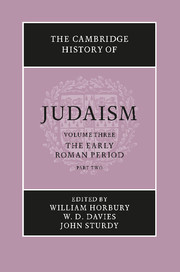Book contents
- Frontmatter
- 1 The archaeology of Palestine 63 bce–ce 70
- 2 The Herodian Temple
- 3 Recent archaeology in Palestine: achievements and future goals
- 4 The contribution of Jewish inscriptions to the study of Judaism
- 5 The social, economic and political history of Palestine 63 bce–ce 70
- 6 The Diaspora in the Roman period before ce 70
- 7 The Gentiles in Judaism 125 bce–ce 66
- 8 Gentiles as seen by Jews after ce 70
- 9 The synagogue
- 10 The Temple and the synagogue
- 11 The early liturgy of the synagogue
- 12 Women in the synagogue
- 13 The Pharisees
- 14 The Sadducees – their history and doctrines
- 15 The Essenes
- 16 The baptist sects
- 17 The troublemakers
- 18 The Samaritans and their sects
- 19 Galilean Judaism and Judaean Judaism
- 20 Jesus: from the Jewish point of view
- 21 Paul: from the Jewish point of view
- 22 Jewish Christianity
- 23 Apocalyptic: the disclosure of heavenly knowledge
- 24 The Qumran sectarian writings
- 25 The Dead Sea Scrolls and pre-Tannaitic Judaism
- 26 Prayer in the Qumran Texts
- 27 Philo of Alexandria
- 28 Josephus (ce 37–c. 100)
- 29 The rabbi in second-century Jewish society
- 30 The Hellenistic–Roman Diaspora ce 70–ce 235: the archaeological evidence
- 31 The legacy of Egypt in Judaism
- 32 Jewish elements in gnosticism and magic c.ce 70–c.ce 270
- Bibliographies
- Index
- References
26 - Prayer in the Qumran Texts
Published online by Cambridge University Press: 28 March 2008
- Frontmatter
- 1 The archaeology of Palestine 63 bce–ce 70
- 2 The Herodian Temple
- 3 Recent archaeology in Palestine: achievements and future goals
- 4 The contribution of Jewish inscriptions to the study of Judaism
- 5 The social, economic and political history of Palestine 63 bce–ce 70
- 6 The Diaspora in the Roman period before ce 70
- 7 The Gentiles in Judaism 125 bce–ce 66
- 8 Gentiles as seen by Jews after ce 70
- 9 The synagogue
- 10 The Temple and the synagogue
- 11 The early liturgy of the synagogue
- 12 Women in the synagogue
- 13 The Pharisees
- 14 The Sadducees – their history and doctrines
- 15 The Essenes
- 16 The baptist sects
- 17 The troublemakers
- 18 The Samaritans and their sects
- 19 Galilean Judaism and Judaean Judaism
- 20 Jesus: from the Jewish point of view
- 21 Paul: from the Jewish point of view
- 22 Jewish Christianity
- 23 Apocalyptic: the disclosure of heavenly knowledge
- 24 The Qumran sectarian writings
- 25 The Dead Sea Scrolls and pre-Tannaitic Judaism
- 26 Prayer in the Qumran Texts
- 27 Philo of Alexandria
- 28 Josephus (ce 37–c. 100)
- 29 The rabbi in second-century Jewish society
- 30 The Hellenistic–Roman Diaspora ce 70–ce 235: the archaeological evidence
- 31 The legacy of Egypt in Judaism
- 32 Jewish elements in gnosticism and magic c.ce 70–c.ce 270
- Bibliographies
- Index
- References
Summary
The Dead Sea Scrolls are the single most valuable source for the study of Jewish prayer in the Second Temple period. Other evidence for Jewish prayer practice during this period is notoriously ambiguous: what prayers are preserved appear almost exclusively in literary contexts – either narratives or poetic collections – and references to liturgical prayer are rare. By contrast, in the Dead Sea Scrolls are collections of prayer texts for various designated occasions and indications of a detailed cycle of liturgical prayer such as is otherwise only clearly attested after the destruction of the second temple. Thus, this body of data is potentially a valuable link between the mostly ad hoc prayers glimpsed in the Hebrew Bible and the later synagogue liturgy.
On the other hand, neither the source of these prayers nor the relationship between those who prayed them and Judaism at large are obvious. Some view the prayers in the Dead Sea Scrolls as sectarian products representing a marginal practice of limited relevance to the study of Jewish prayer in general. According to this view, the Yaḥad (a common self-designation for the sectarian community in the Qumran texts) developed its liturgy in the place of the sacrificial cult from which it was alienated, anticipating by over two centuries the ‘service of the heart’ which would emerge after the destruction of the second temple. However, a growing conviction among scholars that many of the Dead Sea Scrolls did not originate within the Qumran community – and many of the prayer texts fall into this category – raises the possibility that these prayers reflect Jewish practice more widely.
- Type
- Chapter
- Information
- The Cambridge History of Judaism , pp. 852 - 876Publisher: Cambridge University PressPrint publication year: 1999
References
- 3
- Cited by

